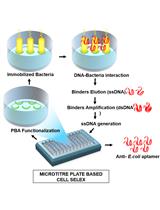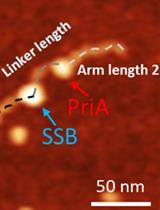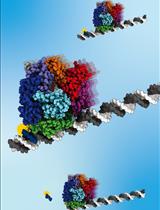- EN - English
- CN - 中文
KMnO4 Footprinting
高锰酸钾足迹法
发布: 2012年11月05日第2卷第21期 DOI: 10.21769/BioProtoc.280 浏览次数: 27235
Abstract
The KMnO4 footprinting method offers a rapid and easy way to detect and localize single-stranded regions within a duplex DNA molecule, such as it occurs for instance within an actively transcribing RNA polymerase-DNA complex or during R-loop formation in DNA-RNA hybrid structures. The method is based on the selective oxidation of single-stranded thymines in DNA. The modified nucleotides react with strong bases by ring opening and subsequent phosphodiester cleavage. Because the modified nucleotides will not be recognized by DNA polymerase sites of modification can also be analyzed by primer extension with Klenow DNA polymerase, which stops elongation one residue before the modification. Hence, localization of the modified base positions can be performed on denaturing polyacrylamide gels either after piperidine catalyzed phosphodiester cleavage of 3'- or 5'-32P-end-labeled DNA or by primer extension with non-labeled DNA employing 32P-labeled oligonucleotide primers. Due to the fact that KMnO4 can penetrate through membranes the footprinting method can also be used for footprint analyses within living cells.
Keywords: Single-stranded DNA localization (单链DNA定位)Materials and Reagents
- Radiolabeled DNA fragment of interest
- 14.3 M β-mercaptoethanol
- 500 mM EDTA
- Phenol
- Bromophenol blue (Sigma-Aldrich, catalog number: BO126 )
- Xylene cyanol (Sigma-Aldrich, catalog number: X4126 )
- Formamide deionized (Panreac Applichem, catalog number: A2156 )
- Cholorophorm
- Piperidine, purity grade: pro analysis (p.a.) (e.g. Sigma-Aldrich, catalog number: 411027 )
- Ethanol (purity grade: pro analysis) (p.a.)
- X-ray films
- Glycogen (1 μg/μl) (e.g. Roche, catalog number: 10901393001 )
- NaOAc (300 mM pH = 5.5)
Optional for Procedure B (primer extension analysis) - Non-radio labeled DNA fragment of interest
- 5'-32P-labeled desoxyoligonucleotide primer
- NaOH (10 mM)
- Tris
- MgSO4
- DTT
- Klenow fragment of DNA polymerase I (e.g. Biolabs, catalog number: MO210S )
- NH4OAc
- 370 mM KMnO4 stock solution (a 1:1 dilution with H2O is used for the reaction) (see Recipes)
- Phenol/Chloroform (see Recipes)
- Neutralization solution (see Recipes)
- dNTP mix (see Recipes)
- Stop mix (see Recipes)
- Electrophoresis loading buffer (see Recipes)
Equipment
- Table-top centrifuge
- Vortex shaker
- Incubator
- Polyacrylamide gel electrophoresis system
- Vacuum concentrator
Procedure
文章信息
版权信息
© 2012 The Authors; exclusive licensee Bio-protocol LLC.
如何引用
Pul, Ü., Wurm, R. and Wagner, R. (2012). KMnO4 Footprinting. Bio-protocol 2(21): e280. DOI: 10.21769/BioProtoc.280.
分类
分子生物学 > DNA > DNA-蛋白质相互作用
您对这篇实验方法有问题吗?
在此处发布您的问题,我们将邀请本文作者来回答。同时,我们会将您的问题发布到Bio-protocol Exchange,以便寻求社区成员的帮助。
提问指南
+ 问题描述
写下详细的问题描述,包括所有有助于他人回答您问题的信息(例如实验过程、条件和相关图像等)。
Share
Bluesky
X
Copy link












